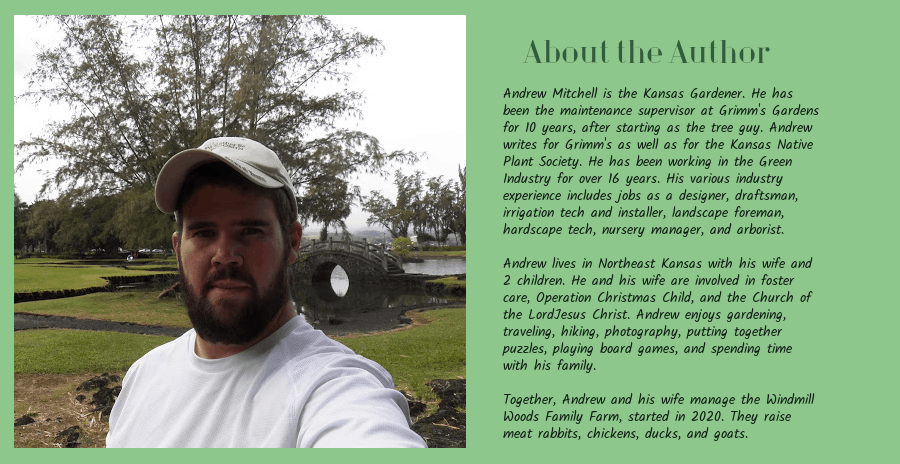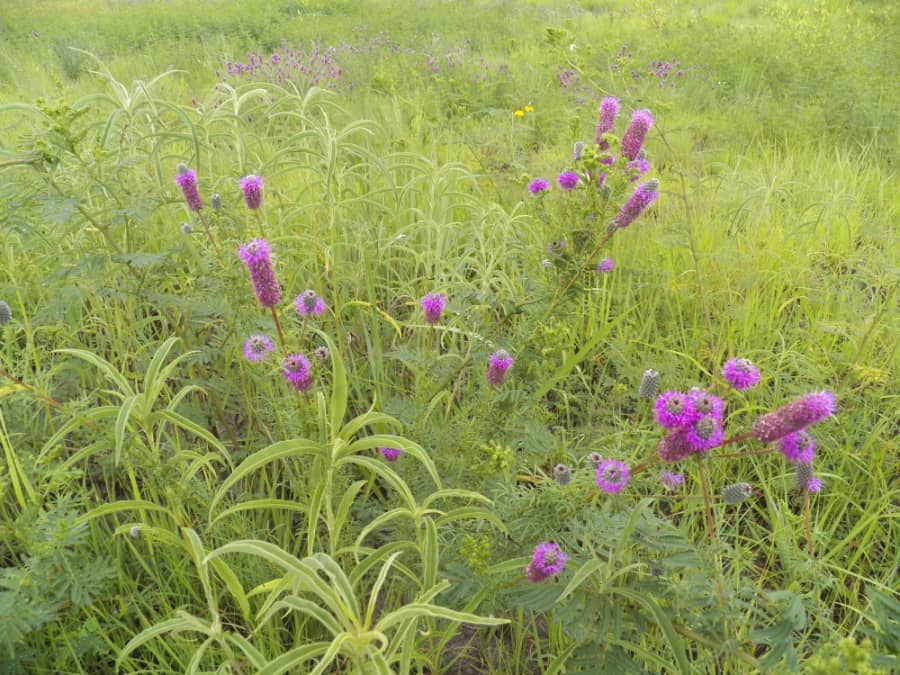I have mentioned the meadow garden many times now. Why do you think that is? I love the native prairie and the application of prairie into the landscape is not an easy one for most homeowners. But you can create a meadow garden in almost any landscape. The meadow is similar to a glade, in forested areas. In other words, it is an open expanse of grass and wildflowers surrounded by thickets and trees.
The meadow can be huge, acres in size, or tiny, as small as a 10 foot by 10 foot area. You can incorporate boulders, or ponds, or almost anything into it. When I picture a meadow garden, I see tall grasses waving in the breeze, with a scattering of wildflowers, as well as the humming of insects and gentle whisper of birdsong.
Meadow gardens are made up of at least 60% grass, mixed with wildflowers. They need full sun (at least 6 hours of direct sunlight). There is a myriad of plants to choose from when designing your meadow garden, and several ways of planting it. Start with an idea of which plants you want, then put a design on paper, then set a budget. It may be necessary to create a meadow garden over several years.
Picking the Plants for the Meadow Garden
Now, to actually put the design together, you will need to know which plants to use for the design of your meadow garden. Meadow gardens should be at least 60% grass and 30-40% perennials/annuals. I do not recommend using wildflower seed mixes unless they identify all the seeds inside. Many seed mixes have filler species to take up space and provide some blooms quickly, but can be very weedy.
I would recommend mostly native plants for your meadow, but you can include some nonnatives if they are not invasive or aggressive. If you are putting in a smaller meadow garden (less than 1000 square feet), I would suggest using mostly plants or plugs. For meadows larger than 1000 square feet I would suggest seeds with some plugs.
Seed mixes can be found at the following places:
- Sharp Brothers Seed
- American Meadows
- Prairie Moon Nursery
- Prairie Nursery
Grasses
As I said above, most meadow gardens will need 60% grasses. This is because grasses are a resting place for the eyes, and because they help add balance and texture to the meadow. I had an original meadow on our property which was converted to pasture for our dairy goats, but it had 70% grasses. The easiest way to calculate this is when designing. Seed mixes should give a percentage of seeds available in them. Or if using plants or plugs, add up the number of total plants and total number of grasses. Divide grasses by total plants to get percentage.
Native Grasses
The following native grasses can be used in meadows in Zones 5 to 7, in the Central Great Plains and Midwest regions. Cultivars are not included, because there are so many available.
- Little Bluestem (Schizachyrium scoparium)
- Switchgrass (Panicum virgatum)
- Big Bluestem (Andropogon gerardii)
- Blue Grama (Bouteloua gracilis)
- Sideoats Grama (Bouteloua curtipendula)
- Broomsedge Bluestem (Andropogon virginicus)
- Buffalograss (Buchloe dactyloides)
- Canada Wildrye (Elymus canadensis)
- Indiangrass (Sorghastrum nutans)
- Prairie Dropseed (Sporobolus heterolepis)
- Rice Cutgrass (Leersia oryzoides)
Nonnative Grasses
Nonnative grasses should be used in moderation in meadows, but can be useful as long as they are not invasive.
- Miscanthus sinensis
- Feather Reed Grass ‘Karl Foerster’
- Blue Fescue ‘Blue Whiskers’
Sedges
Native sedges are grass-look-a-likes, but are an integral part of the meadow or prairie ecosystem. While many nurseries do not sell sedge directly, they can help you find them. Add some of the following full-sun sedges to your meadow.
- Mead’s sedge – Carex meadii
- Fox sedge – Carex vulpinoidea
- Plains sedge – Carex inops
- Texas sedge – Carex texensis
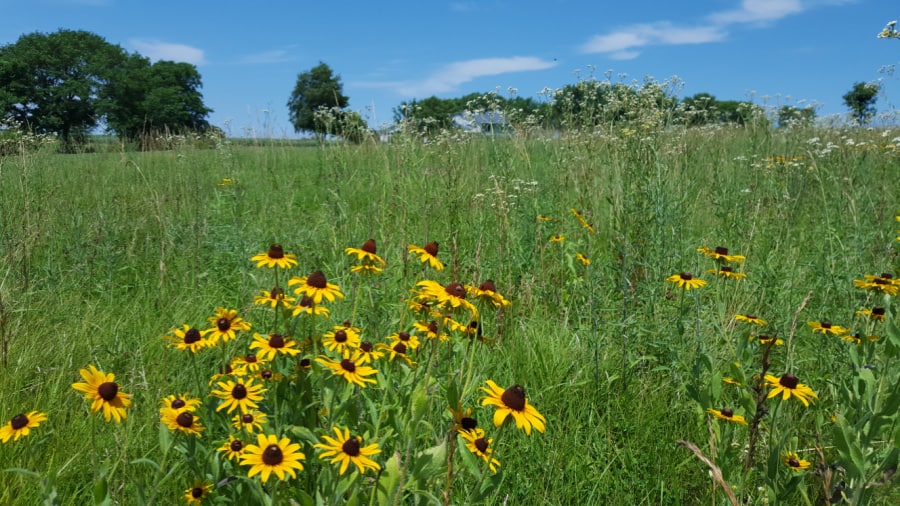
Perennials
Choosing perennials for the meadow garden can be the most exciting part of the process, for many of us gardeners. But we need to remember that some plants take longer to get established and may need to be planted a year in advance of other perennials. Some bloom quickly, in the first year and can out grow other perennials. So we must separate potential lists of perennials into 3 types: long-term establishers, quick establishers, and thugs. Thugs spread by rhizomes or quickly by seed and should be planted last, or kept at bay by regular weeding.
LONG TERM ESTABLISHERS – YEAR 1 PLANTINGS
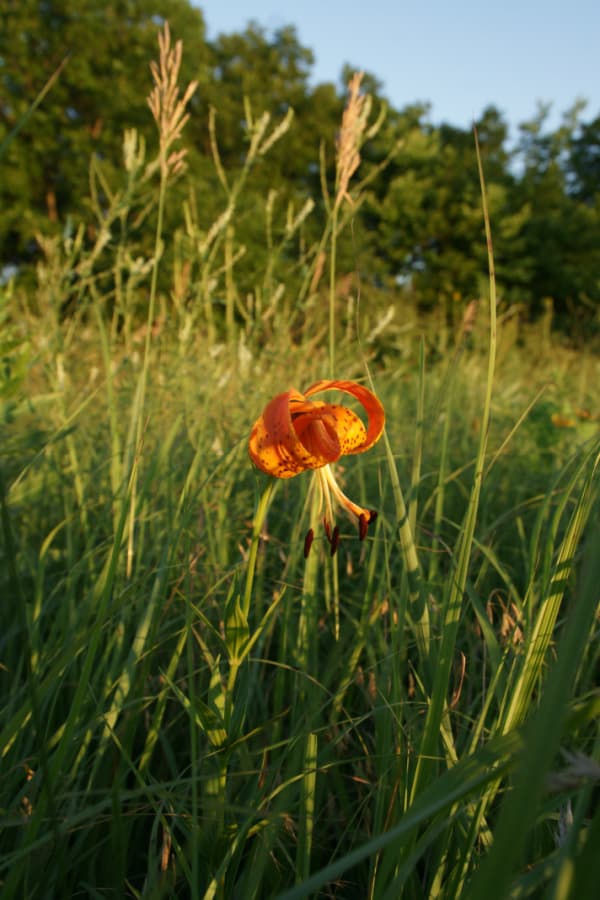
- Blue False Indigo – Baptisa australis cultivars
- Prairie Dock – Silphium terabinthinaceum
- Butterfly Milkweed – Asclepias tuberosa
- Rattlesnake Master – Eryngium yuccafolium
- Arkansas Bluestar – Amsonia hubrichtii
- Willowleaf Sunflower ‘First Light’
- Prairie Blazingstar – Liatris pycnostachya
- Giant Coneflower – Rudbeckia maxima
- Compassplant – Silphium laciniata
- New England Aster – Symphyotrichum nova-angliae
- Purple Prairie Clover – Dalea purpurea
- Maryland Senna – Senna marilandica
- Obedient Plant – Physostegia viginiana
- Michigan Lily – Lilium michagense
- Blue Lobelia – Lobelia silphilitica
- Leatherflower – Clematis fremontii
- White Wild Indigo – Baptisia alba
- Culver’s Root – Veronicastrum virginicum
- Siberian Iris cultivars – Iris siberica
QUICK ESTABLISHERS – YEAR 2 PLANTINGS
- Swamp Milkweed – Asclepias incarnata
- Purple Coneflower – Echinacea purpurea
- Pale Purple Coneflower – Echinacea pallida
- Slender Mountain Mint – Pycnanthemum tenufolium
- False Sunflower – Heliopsis helianthoides
- Button Blazingstar – Liatris aspera
- Missouri Goldenrod – Solidago missouriensis
- Woolly Verbena – Verbena stricta
- Bradbury’s Beebalm – Monarda bradburiana
- Betony ‘Hummelo’
- Fall Phlox – Phlox paniculata
THUGS – YEAR 3 PLANTINGS OR PLANT WITH CAUTION (ANNUALS ARE HERE)
- Golden Alexanders – Zizia aurea
- Whorled Milkweed – Asclepias verticillata
- Common Milkweed – Asclepias syriaca
- Showy Milkweed – Asclepias speciosa
- Bigflower Coreopsis – Coreopsis grandiflora
- Maximilian Sunflower – Helianthus maximiliani
- Greyhead Coneflower – Ratibida pinnata
- Little Brown-Eyed Susan – Rudbeckia triloba (biennial)
- Black-Eyed Susan – Rudbeckia hirta
- Clasping Coneflower – Rudbeckia amplexicaulis (annual)
- Western Ironweed – Vernonia baldwinii
- Blue Sage – Salvia aurea
- Common Sunflower – Helianthus annuus (annual)
- Zinnia (annual)
Bulbs and Ephemerals
One thing that many meadow garden designers and planters forget about are bulbs and ephemerals. These are plants that will produce leaves in early spring and into summer, and flowers in early spring or fall. The leaves typically die to the ground in the heat of the summer or are shaded over by taller grasses and perennials. Add some to your meadow and plant them in the first year or fall of the first year as they are available.
BULBS
- Daffodils
- Tulips
- Crocus
- Winter Aconite
- Hyacinths
- Allium
- Grape Hyacinth
EPHEMERALS
- Bleeding Heart – Dicentra spectabilis
- Carolina Anemone – Anemone caroliniana
- Pasque Flower – Pulsatilla patens
- Prairie Smoke – Geum triflorum
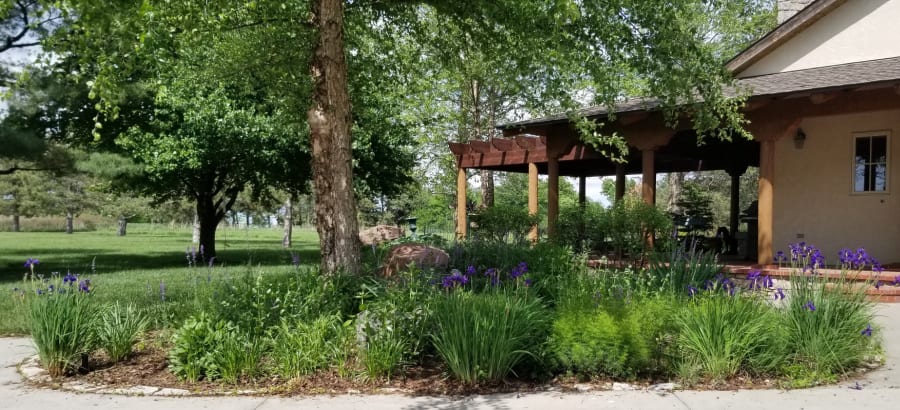
Designing Your Meadow Garden
There are many sources of inspiration when beginning to develop your plan for the meadow garden. Take a walk into a native prairie, if you can find one. Look into some books of design. Browse photos online. Here are some places to go and books to look at:
Places of Inspiration for Meadows
- Tallgrass National Prairie Preserve – Strong City, KS
- Konza Prairie – Manhattan, KS
- Indian Boundary Prairies – Chicago, IL
- Zumwalt Prairie Preserve – Enterprise, OR
- Miller Prairie – Wheaton, MN
- Platte River Prairies – Grand Island, NE
- Prairie Border Nature Preserve – Wheatfield, IN
- Stillwell Prairie – Richards, MO
Books for Inspiration of Meadow Design
- Planting, A New Perspective – Piet Oudolf & Noel Kingsbury
- The Know Maintenance Perennial Garden – Roy Diblik
- The American Meadow Garden – John Greenlee
Step 1 – The Design
Having an on-paper design for you meadow garden is essential. If you are like me, you may be able to pop plants into the garden without one, but you will not remember where they are next season. Therefore, a design is important. Knowing different aspects of your site, the plants, and maintenance will help you create both a good design and plan of execution for implementation of it.
Before you begin you design, you will need to know the following things about your proposed site for the meadow garden:
- Amount of sun per day during the growing season (April-September)
- Slope (is it level, sloped, or depressed)
- Soil Type (Sand, Silt, Clay, or a mix)
- Geographical Location (this will determine the species available for your seed or plant mix)
- What is existing in the location (is it a black space, a lawn, or weedy patch?)
Here is an example of an area I am planning to put into a meadow garden next season:
- 6 to 8 hours of sun per day
- Sloped southward
- Clay-silt loam
- Zone 5b, Northeast Kansas
- Existing landscape bed, no edging, heavy on perennials, some native broomsedge bluestem and Mead’s sedge.
Putting the design on Paper
Begin by measuring the dimensions of the site and noting any immovable objects like boulders or existing trees. In my own example, I have an existing black oak tree which will be removed before planting.
Graphing paper works best for preparing a design, and a 1/8 inch to 1 foot scale works best for most small designs. For larger, more extensive meadow gardens, you may want to have a professional landscape designer help with the initial planning. But use this post to help.
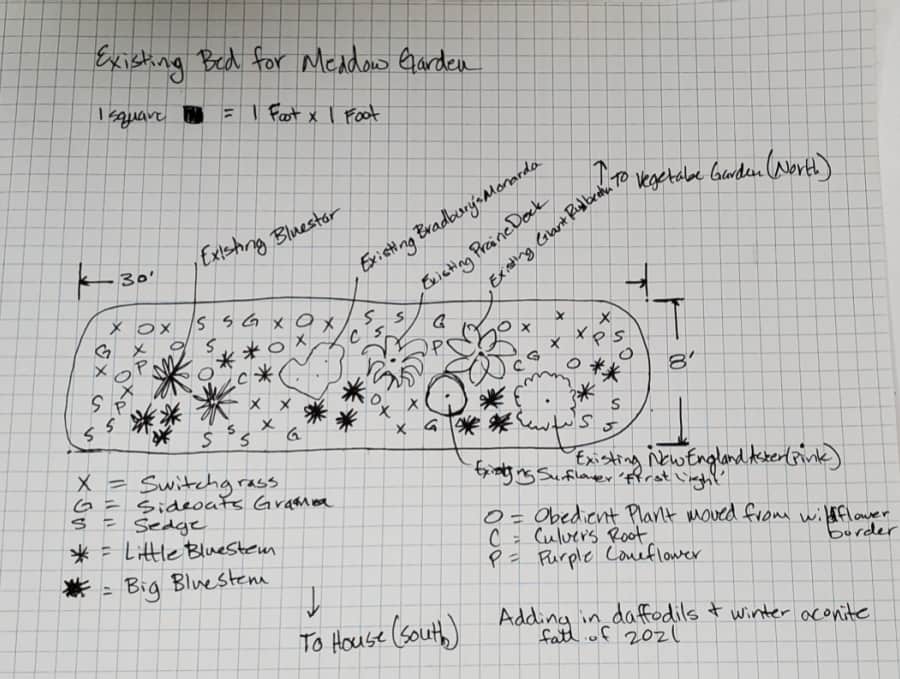
Step 2 – Combining Plants
Once your are ready to put your planting design on paper, take your list of desired plants and get ready to combine them. To mimic nature, you want your meadow garden to have a scattering of grasses and sedges throughout it, and some placed into distinct clumps or masses. Put these down on paper first, before the perennials and annuals.
Perennials can be grouped together by alternating textures. This means that you plant perennials with round leaves next to ones with narrow leaves, as an example.
Example: plant prairie dock (large oval leaves) with willowleaf sunflower ‘First Light’ (narrow leaves) and Culver’s root (narrowly oval, whorled leaves).
Bed Preparation and Planting Your Meadow Garden
Now that you have your design down on paper, you need to look at preparing your space for the actual planting. If you are using a seeding mix, the preparation is slightly different than for planting or plugging.
Bed Preparation and Planting for a Seeding Mix
If you are using a seeding mix for planting your meadow, then you are going to want a finer soil to seed ratio than if using a planting or plugging plan. Indeed, if you are seeding, then no plan is necessary (unless you are adding plants in later). Seeding is best done in late summer (September) or late spring (May).
- Begin by removing excess or existing plant materials. This can be done by string-trimming or brush cutting down to bare soil, letting it regrow slightly, then using a weed killer to kill off existing plants. If you are planning several months in advance, you can kill existing plants by smothering them with a silage tarp or black plastic.
- I do not recommend tilling the soil before planting as this brings up weed seeds and destroys soil structure. Apply a fine layer (1 to 2 inches) or compost or a compost/vermiculite mixture over the planting area.
- For smaller areas, hand broadcast the seeds over the seedbed and go over it with a weighted lawn roller. For larger areas, you can use a tractor and seeder.
- Apply a layer of chopped alfalfa or prairie hay mulch over the whole area. Water with overhead irrigation, daily until emergence of the grass, and then 2 times per week until first frost.
Bed Preparation and Planting with Plants or Plugs
This is best done when plants are available, in June for most nurseries. September to October are also good times to plant plants, as long as you can get them.
- Begin as above by removing unwanted plants or weeds. You can choose to start with a black slate by smothering all with a silage tarp or black plastic. Or you can remove certain weeding species by hand pulling, spot spraying, or string-trimming. In my own case, I am hand pulling the undesirable plants (mostly western ragweed) for the bed before planting.
- If you are starting with a blank slate, then apply a layer of compost or compost/vermiculite mix 1-2 inches deep over the whole area. Lay our your plants according to the design.
- Plant the plants (or plugs) and mulch around them with chopped alfalfa, prairie hay, or chopped leaves. Water daily for 2 weeks with overhead irrigation and then 2 times per week until frost.
Maintenance of the Meadow Garden
After the meadow garden has been established and is growing well, we need to think about the different kinds of maintenance chores associated with it. During the growing season, it may be necessary to pull weeds within the meadow, and keep plant thugs from taking over. Weedy thugs that are not part of the meadow include species such as:
- Western ragweed
- Common ragweed
- Giant ragweed
- Bindweed
- Honeyvine milkweed
- Crabgrasses
- Goosegrass
- Puncture Vine
- Spotted spurge
- Purslane
- Hairy Aster
- Old-world bluestem
- Sericea lespedeza
Spring Maintenance
I would recommend leaving the meadow garden up completely through fall and winter. This allows overwintering insects a place to sleep peacefully. While some of these would include pests, many overwintering insects are beneficials or pollinators. Many of our butterfly and moth species overwinter as adults in leaf litter, while other are pupa or even caterpillars in hollow stems.
The best thing for a large meadow is burning, but this may not be an available option in every situation. In my own gardens, I burn off my Monarch Waystation and meadows every other year. Burning is the best option for a grass filled meadow garden, and can be easier than mowing or cutting down the plants.
If you are not in the position to burn off the meadow, use a brush mower for large areas or a garden tractor and mower or weed trimmer for smaller areas. Leave the cuttings where they fall, the new plants will grow out above them.
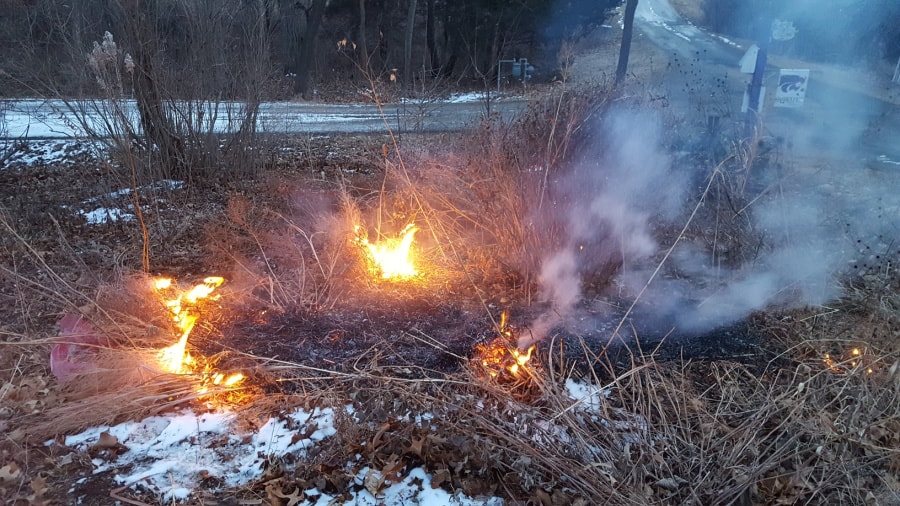
Long-Term Maintenance
Over the years, the meadow garden may become choked with undesirable species, if left unchecked. It is important to regularly pull weeds and divide or thin out thug plants. Even the best meadow garden can turn into a weed mess if yearly maintenance is missed. Some plants are not as long-lived as others, and may disappear after a few years. These, if desired, may need to be replanted every few years. Purple coneflower (Echinacea purpurea) is an example of this.
Conclusion
Creating a meadow garden can be a fun and exciting part of your gardening life, if you choose a proper place and use good materials. Maintenance, as always, is an integral part of keeping gardens looking their best. The meadow garden can be an abundance of life for insects, small mammals, reptiles, amphibians, birds, and more. Enjoy it.
Happy planting!
